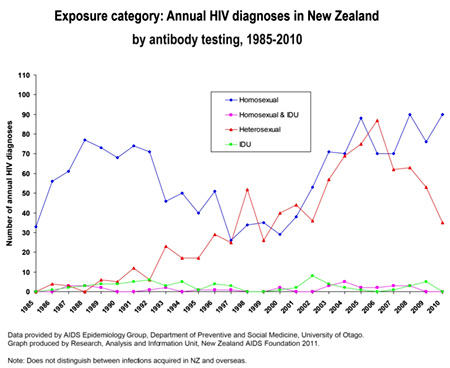The latest HIV figures from the AIDS Epidemiology Group at the University of Otago reveal that 90 MSM were diagnosed with HIV through antibody testing in 2010, compared to 35 (17 men and 18 women) through heterosexual contact, and one child through mother-to-child transmission.

Of the 90 MSM, 64 (71%) were European, 9 (10%) Māori, 9 (10%) Asian, 1 (1%) Pacific, and 7 (8%) ‘other’ or unknown ethnicity. Almost half (40%) were living in Auckland, 28% in Wellington, 10% in other parts of the North Island, 17% in the South Island, and 5% overseas at the time of diagnosis. The average age of these MSM was 38 years. Two (2%) were in the 15-19 year age group, 27 (30%) aged 20-29 years, 22 (24%) aged 30-39 years, 24 (27%) aged 40-49 years, and 15 (17%) aged 50 or more. While these data do not show the age at the time of infection it indicates that among MSM, HIV infection should be considered across a wide age range.
Of the total of 149 people diagnosed with HIV, 15 of the 23 people for whom the cause of HIV transmission was still unknown were likely to be gay or bisexual men.
Based of the numbers, Shaun Robinson, the newly appointed NZAF Executive Director says 2010 could be "the worst year on record for our gay men’s communities."
The previous peak in MSM infections was 93 in 2008.
"Not even in the early days of AIDS in the 1980s were rates of infection this bad in New Zealand," Robinson said in a statement released on March 7, 2011 on the New Zealand AIDS Foundation website.
He says HIV testing will remain critical if New Zealand is to control the HIV epidemic.
“A large proportion of the gay and bisexual men were not diagnosed with HIV until their infection was past the point when treatment should have begun. These men may have had HIV and been sexually active for a long time before they were diagnosed which means they missed out on treatment and they were also likely to be more infectious”, states Robinson. “This situation could have been avoided by regular HIV testing – which is both free and easy.”
The best estimate of the number of people living with HIV in New Zealand in 2010 is 1800. The majority of these will be gay and bisexual men, according to NZAF.
In 2010, 39 people were notified to have developed AIDS of which 25 were men infected through sex with other men, 11 (6 men and 5 women) through heterosexual contact.
To view the report in the AIDS New Zealand Newsletter, click onto Issue 67– February 2011 (PDF).

